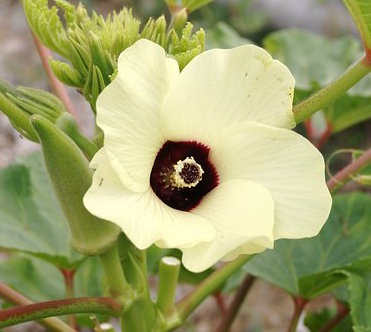Tropical Garden Grow Guide
Where you are the student and the teacher

Okra Flower


to grow and eat as a featured plant for the month of May.
(Submitted by Josie Flowers)
Okra
.
Okra is a warm weather crop that grows best in
full sun. It is adaptable and will grow in most
soils, though it performs best in well-drained soil that
is rich in organic matter such as compost. I really
liked the Black Kow compost that I purchased at Reimers
Feed Mill. However, a local less expensive source is Pyta
Compost. Remember to work compost well into the first 6
inches if your native soil. If you are interested to
testing your soil Ph before planting you can purchase a
Rapitest Ph soil tester at Universal Hardware. .
A common variety found at Reimers Feed Mill or Prosser Fertilizer is the Clemson Spineless. It is preferred for its tender pods as well as for not having those tiny spines that irritate your skin. Some other interesting varieties to look out for are Cow Horn, Burgundy and Zing Orange (pictured below) but there are many more out there to try out.

Okra can be grown all year round in Belize. Sow okra seeds about ½ to 1 inch deep and be sure to space them 3 to 4 feet apart in either direction to give them room to grow. You can soak the seeds overnight in lukewarm water to help germination. When the seeds are up, fertilize monthly with an organic fertilizer. I’ve found Jobes and/ or Espoma at Universal Hardware. It is suggested to water about 1 inch per week, but be sure to provide more if it is very hot.
Okra produces very quickly and is ready to harvest about 2 months after planting. Harvest the okra when it’s about 2 to 3 inches long every other day. According to the Farmer’s Almanac “Cut the stem just above the cap with a knife; if the stem is too hard to cut, the pod is probably too old and should be tossed. Remember wear gloves and long sleeves when cutting the okra because most varieties are covered with tiny spines that will irritate your skin, unless you have a spineless variety. Do not worry: this irritation will not happen when you eat them.”
After the first harvest, remove the lower leaves to help further and continue production. Also if your okra plant is getting too tall you can cut the leader steam to make the plant shorter. This will also encourage the plant to grow more vertical productive stems which will increase your harvest.
It is common in our wet and humid climate for the okra plant to get powdery mildew which is a fungal disease. Please find below an outline of ways to treat powdery mildew.
HOW TO TREAT POWDERY MILDEW
If your plants do develop powdery mildew despite your best efforts, don’t worry. There are many environmentally friendly options for eliminating the disease, including:
If your plants do develop powdery mildew despite your best efforts, don’t worry. There are many environmentally friendly options for eliminating the disease, including:
- Baking Soda: Baking soda itself isn’t normally effective as a powdery mildew treatment, but when it’s combined with liquid soap and water, it can be a powerful weapon. It’s normally most beneficial if used as a preventative measure rather than a treatment. Combine one tablespoon baking soda and one-half teaspoon of liquid, non-detergent soap with one gallon of water, and spray the mixture liberally on the plants.
- Mouthwash: The mouthwash you may use on a daily basis for killing the germs in your mouth can also be effective at killing powdery mildew spores. Since its function is to kill germs, the powdery mildew spores can’t withstand it. Using three parts water to one part mouthwash has been found to be a good ratio, but new growth can be damaged since mouthwash is potent, so use with caution.
- Milk: Milk is making its way onto the scene as a viable means to control powdery mildew. Not all the science is known, but the compounds in milk may be able to act as an antiseptic and fungicide as well as potentially increase the plant’s overall immunity. It tends to be effective as a method of preventing powdery mildew on zucchini and other types of squash, as well as cucumbers. An effective mixture ratio is about one part milk to two or three parts water.
- Organic Fungicide Treatments: If you don’t want a do-it-yourself solution, there is a variety of commercial treatment options that are just as environmentally friendly and approved for organic gardening. By going this route, you also know exactly what types of pests the treatment will kill and which types of plants it’s most helpful for.
- Water. Since dry conditions coupled with high
humidity are often the culprits behind powdery mildew
growth, watering your plants overhead and getting the
entire plant wet can help. However, it’s important to
use this method somewhat sparingly as over-watering
can cause other issues for your plants. (https://www.saferbrand.com/articles/treat-powdery-mildew-plants)
If you would like to try a new way to enjoy okra please find Fried Okra Patties recipe below.
Let us know if you like it.
Fried Okra Patties
From https://www.bigoven.com/recipe/fried-okra-patties/165942
INGREDIENTS
- Vegetable oil for frying
- 1 lb fresh okra; chopped fine
- 1 cup onion; chopped fine
- 2 jalapenos; (or 3) or habanero
- 3 tablespoons garlic; minced
- 3 teaspoon Tony's Cajun Seasoning; or favourite season salt
- 3 teaspoon red pepper
- 1/2 teaspoon black pepper
- 1 cup water
- 2 eggs
- 1 teaspoon baking powder
- 1 cup cornmeal
- 1/2 cup all-purpose flour
INSTRUCTIONS
Pour oil into large skillet (should be at least an inch deep) and heat on medium high or 375 degrees.
In a large bowl, mix okra, onion, pepper, seasonings water and egg. Combine flour, baking powder and cornmeal together; and then stir both mixtures together.
Carefully place a large spoon of okra batter into the hot oil, fry each side until golden brown, about 3 minutes per side. Remove patty using a slotted spoon and allow draining on paper towels.
See canning instructions here
